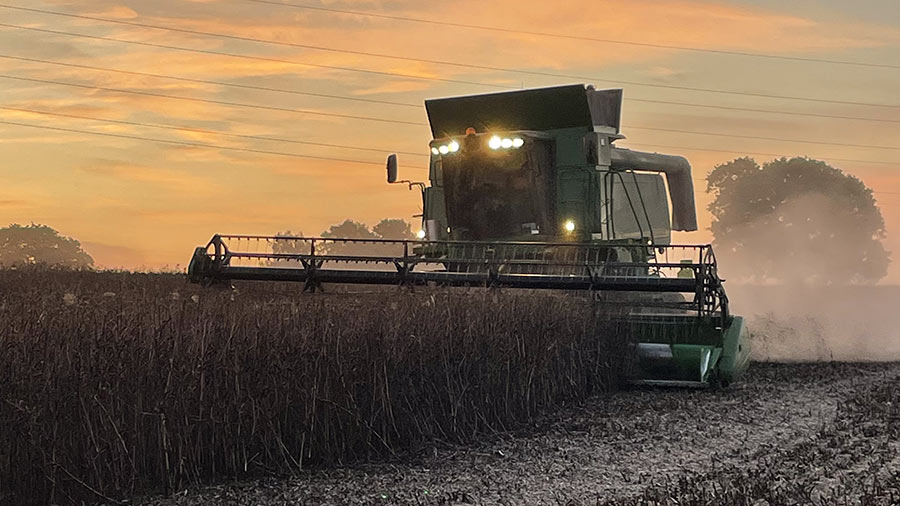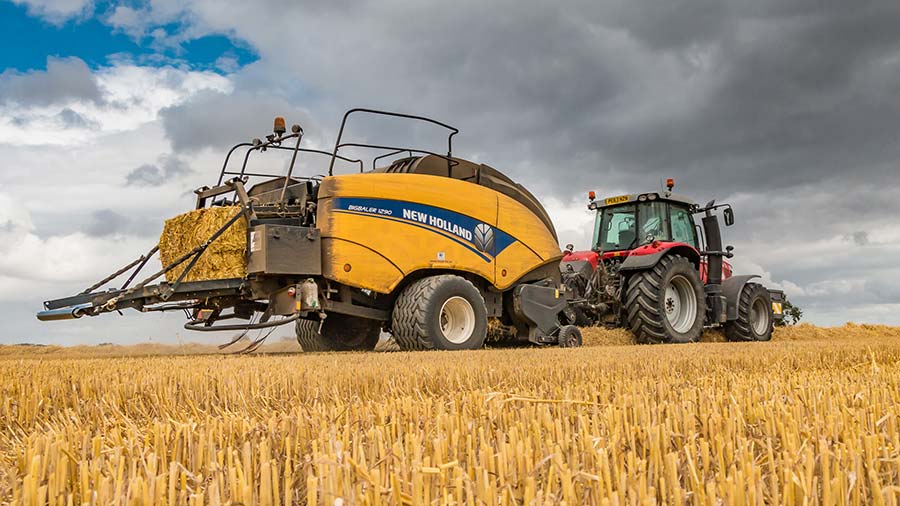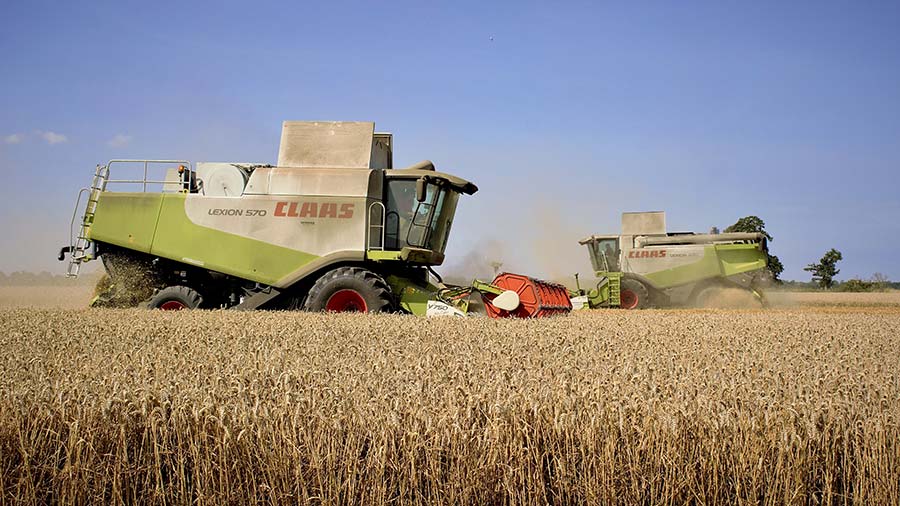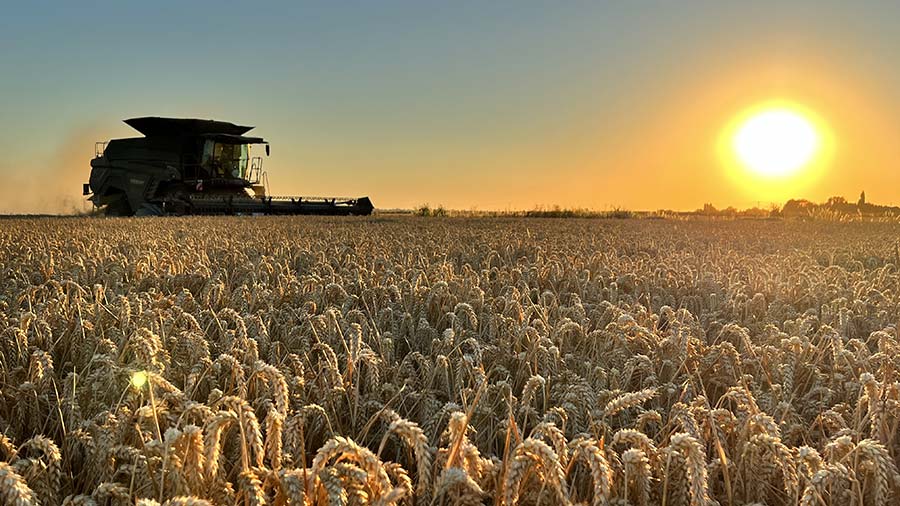Harvest 2022: Drought hits spring bean and wheat yields
 Alvin Musson starting early, on the beans, in Rutland to beat the heat - photo submitted to our Harvest gallery by Steve
Alvin Musson starting early, on the beans, in Rutland to beat the heat - photo submitted to our Harvest gallery by Steve Wheat yields and protein contents are varying between good and average due to dry conditions, and there are concerns over rapeseed establishment.
We check in with farmers across the country to find out harvest progress and show off some of the photos from our Harvest photo gallery.
See also: Are no-till potatoes a pipe-dream?
Herefordshire
At Lower Blakemere Farm near Blakemere, Phil Gorringe is close to completing his spring wheat, with winter wheat finished on 21 August.
The crops are mainly grown for seed, and Siskin yields have been pleasing at 7.4-8.5 t/ha, with moisture content down at 12%. “The last 20ha of winter wheat was 20% [moisture], so that will need drying,” says Mr Gorringe.
Mr Gorringe has modest expectations for the spring wheat he is harvesting at present, after taking the risk to drill one field twice after a failed direct-drilling attempt.

A Massey Ferguson 7618 tractor and New Holland Big Baler 1290 at work on Phil Metcalfe’s spring barley straw, Van Farm, Teesdale. Photo submitted by Richard Laidler
Lincolnshire
Moving east, Woldgrain near Gainsborough received 13,500t of wheat and barley last week (w/c 15 August).
The main two varieties of malting barley – Planet and Laureate – both have lower than average nitrogen contents. Of the 7,400t of Planet destined for brewing, nitrogen contents have averaged 1.62%.
The 3,600t of dual-purpose variety Laureate for brewing and distilling has averaged 1.56% – a good low nitrogen for distilling. Specific weights have levelled at 68kg/hl.
Comparing Group 1 milling wheat varieties: 4,300t Skyfall and 2,600t Crusoe have both averaged 12% protein.
While Crusoe had an average Hagberg number of 256, specific weight of 79kg/hl and 15% moisture content, Skyfall averaged 311 Hagberg, 80kg/hl and 14.7% moisture content.
“Last year we had a kerosene delivery (for the grain dryers) every other day,” says Dan Murphy, operations manager. “This year there was a delivery in June, then the next one was 20 August.”
Oilseed rape was also dry, with 7,400t of “00” varieties averaging 7.4% moisture and 46% oil content. Some 1,400t of high oleic, low linolenic acid rapeseed came in at 47% oil content and 6.8%
moisture.

Harvest in E Yorkshire photo submitted to our Harvest gallery by Mini Seed Man
Norfolk
Across in Norfolk, Dewing Grain near Aylsham will have wrapped up harvest by the end of this week (w/c 22 August), three weeks earlier than usual.
“Some areas of Norfolk had critical rain in June which meant yields performed really well,” says Ian Webster, trade director.
Wheat in those areas averaged 9.5t/ha, while other areas with little rainfall were down at 6.5-7.5t/ha. The same goes for protein content; better areas performed at 14%, then 11.5% in others.
Spring beans suffered with no rain since drilling, therefore, average yields have been down at 2-2.5t/ha. “Bruchid beetle levels have been a concern this year,” says Mr Webster.
“Selling to Egypt and Sudan markets means the look of the beans is key. But beetle damage can be accepted at 5%.”
Spring barley nitrogen averaged a disappointing 1.65%, slightly high for the distilling specification, but winter barley averaged 1.4% nitrogen.
“Rapeseed yields are crudely 0.75t/ha better than last year,” says Mr Webster.
“A combination of good establishment, sunlight and rainfall in September aided the good yields. We saw poor oil content last year, this year it’s at 44-45%, but not above 45% like other national averages.”

“My dad Ken Goodger, driving TNS Ideal combine which was kindly lent to us after ours broke down, with parts not available for repairing our combine” – photo submitted to our Harvest gallery by Kim Goodger
Inverness
Up in Scotland, Highland Grain near Glaikmore has taken in 30-45% of the anticipated spring malting barley crop.
Yields have been good, with clean screenings and no signs of grain skinning, while nitrogen content has averaged a decent 1.4%.
Scotland had an unfortunate bout of weather which halted harvest last week, but cutting has started again recently. “Wheat is getting cut too, I have so far seen a Skyscraper sample with a good specific weight and yield,” says chief executive Gary Catto.
As Inverness is high above sea level and temperatures are low, crops take longer to ripen than the rest of the UK.
“Twenty years ago, the older varieties suited the land, now with newer varieties they do not ripen as soon,” says Mr Catto.

